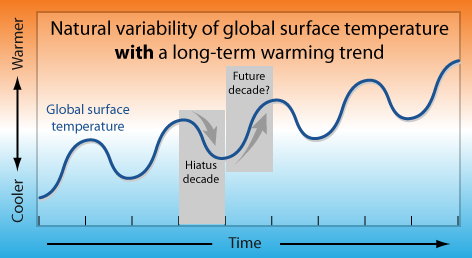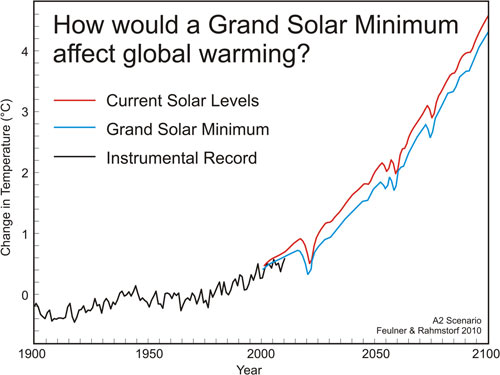Sorting out Settled Science from Remaining Uncertainties
 Much ado is made about the phrase "the science is settled," but to what does the phrase refer? There are certainly a number of climate issues for which the scientific evidence is so conclusive and robust, they can reasonably be called "settled." For example, the fact that the increase in atmospheric CO2 levels is due to human emissions, the fact that the planet is warming (as confirmed once again by the BEST study), and the fact that the increase in CO2 is responsible for a substantial fraction of that warming.
Much ado is made about the phrase "the science is settled," but to what does the phrase refer? There are certainly a number of climate issues for which the scientific evidence is so conclusive and robust, they can reasonably be called "settled." For example, the fact that the increase in atmospheric CO2 levels is due to human emissions, the fact that the planet is warming (as confirmed once again by the BEST study), and the fact that the increase in CO2 is responsible for a substantial fraction of that warming.

New Scientist has published a useful resource on this subject, discussing climate knowns and unknowns.
Fake Skeptics vs. Real Science
Of course, the climate "skeptics" who want to delay and prevent action to address global warming love to argue that "the science is NOT solved." And of course it will always be possible to make that argument, because there will always be aspects of the climate system which we don't fully understand, as is the case for every field of science. For example, we know that there is a global energy imbalance, with more incoming than outgoing energy due to the increased greenhouse effect, which is the underlying cause behind global warming. However, it's difficult to precisely determine that energy imbalance using either satellites or measurements on Earth.
Over the past decade, the warming of global surface temperatures has slowed down. Studies have shown that climate model runs do predict that there will be periods on the order of a decade during which we expect to see this slowed rate of warming, even though the underlying man-made global warming signal remains in place (i.e. Santer et al. 2011):
"Because of the pronounced effect of interannual noise on decadal trends, a multi-model ensemble of anthropogenically-forced simulations displays many 10-year periods with little warming."
If climate models were perfect, they could anticipate these short-term periods of little surface warming. However, there are many different effects which can cause short-term temperature changes. There are also important parts of the climate which we don't yet have good measurements for, such as the amount of heat in the deep oceans, and the amount of aerosols in the atmosphere. Because climate scientists had a difficult time explaining the short-term slowing of the surface warming trend over the past decade, Kevin Trenberth infamously said (in a stolen email),
"The fact is that we can't account for the lack of warming at the moment and it is a travesty that we can't."
There have been a number of recent studies attempting to address this short-term slowed surface warming, which were nicely summarized in this article by Paul Voosen, which quotes a number of different climate scientists who are studying the issue. Unfortunately, certain climate "skeptics" have grossly misrepresented these scientists, depicting them in a mocking caricature, and claiming that in trying to determine the cause of the slowed surface warming, they are just making "excuses." Such is the state of the climate denial community, that they equate scientific research with making excuses.
Many Causes
But back to the science and the causes of the slowed surface warming. As Susan Solomon put it,
"There is no silver bullet. In this case, it's four pieces or five pieces of silver buckshot."
Skeptical Science has discussed many of these contributors to the short-term slowed surface warming. For example, some heat has been temporarily transferred to the deeper ocean layers, as Meehl et al. (2011) demonstrate (Figure 1).

Figure 1: Diagram illustrating "natural variability" with a long-term warming trend.
Additionally, increased human aerosol emissions (primarily from Chinese coal combustion), and more frequent La Niña events over the past decade have had a short-term cooling effect, as Kaufmann et al. (2011) found. A decrease in stratospheric water vapor may have added another short-term cooling effect, as Solomon et al. (2010) concluded, and relatively small volcanic eruptions may be having a larger cooling effect than expected as well, as Vernier et al. (2011) suggest. On top of all that, we just experienced an unusually long minimum in the 11-year solar cycle.
Despite Short-Term Uncertainty, Long-Term Warming Continues
In short, it appears that nearly every significant short-term effect on the global surface temperature was in the cooling direction over the past decade. However, significant uncertainty remains regarding how large of a role each effect played in the short-term slowing of the increase in global surface temperature.
Kevin Trenberth believes the warming of the deep oceans was a major contributor. James Hansen, on the other hand, believes that the increase in atmospheric aerosols can explain most of the offset, and that based on recent research, that the ocean doesn't mix heat into its deep layers as well as climate scientists thought.
If Hansen is right, there is a smaller global energy imbalance, which means less heat "in the pipeline" (less warming that we will experience after we stop increasing atmospheric CO2). However, it also means that aerosols are offsetting more greenhouse gas warming than we previously thought, so as our air becomes cleaner, it will reveal more previously-hidden warming, as discussed in Hansen et al. (2011).
This means that although climate scientists still can't perfectly explain the temporarily-slowed warming of surface temperatures, they know that regardless of the explanation, there is much more global warming left in store. We know this because of the settled science discussed above. We are increasing the amount of CO2 in the atmosphere, and through the greenhouse effect, that increased CO2 will continue to warm the planet.
The short-term effects can only temporarily dampen (or amplify) that long-term man-made global warming trend. For example, aerosols only remain in the atmosphere for a year or two before they're washed out, so the aerosol cooling effect can only continue to offset greenhouse gas warming if we continue to pump more and more aerosols into the atmosphere. However, because they have adverse impacts on human and environmental health (i.e. see the air in China, literally), most countries are trying to reduce their aerosol emissions (including China). El Niño and La Niña are cycles which cancel each other out over the long-term. And while we can't predict how solar activity would change, a solar minimum as big as the largest in the past several centuries would only offset 7 years' worth of man-made warming (Figure 2).

Figure 2: Global mean temperature anomalies 1900 to 2100 relative to the period 1961 to 1990 for the business as usual scenario. The red line represents temperature change for current solar levels, the blue line represents temperature change at Maunder Minimum levels. Observed temperatures from NASA GISS until 2010 are also shown (black line) (Feulner 2010).
The Climate Casino
We can think of the climate like a casino. Any given gamble is unpredictable, and you may very well take money from the casino in a given bet or after a given day's worth of gambling. But the odds are stacked in the casino's favor, so it is certain to make money on average from all the bets that are placed. The longer the timeframe and the more bets that are placed, the more certain the casino can be that it will make money from the gamblers.
Likewise, over short timeframes, global temperature changes can be difficult to predict. However, over the long-run, the underlying man-made global warming trend will dominate as all of those short-term effects average out. Right now the gamblers are on a lucky streak, but it simply cannot last indefinitely. The casino will aways win out in the end, as will the long-term man-made global warming signal.
And in keeping with the casino analogy, by continuing to pump more and more greenhouse gases into the atmosphere, we are all taking a very big gamble with the future of the global climate, and thus with the future of the human race.
Posted by dana1981 on Tuesday, 1 November, 2011
 Much ado is made about the phrase "the science is settled," but to what does the phrase refer? There are certainly a number of climate issues for which the scientific evidence is so conclusive and robust, they can reasonably be called "settled." For example, the fact that the increase in atmospheric CO2 levels is due to human emissions, the fact that the planet is warming (as confirmed once again by the BEST study), and the fact that the increase in CO2 is responsible for a substantial fraction of that warming.
Much ado is made about the phrase "the science is settled," but to what does the phrase refer? There are certainly a number of climate issues for which the scientific evidence is so conclusive and robust, they can reasonably be called "settled." For example, the fact that the increase in atmospheric CO2 levels is due to human emissions, the fact that the planet is warming (as confirmed once again by the BEST study), and the fact that the increase in CO2 is responsible for a substantial fraction of that warming.



